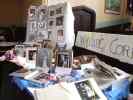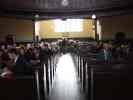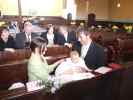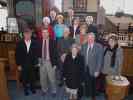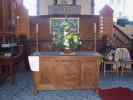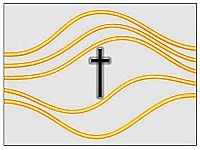|
End of an Era for two
Wick Churches
In his booklet published in 1999 the Reverend A. A. Roy - who retired in 2007 as the last and, having spent 52 years in Wick, the longest serving of the church's eleven Ministers � provides an interesting history of what is currently known as Wick Bridge Street Church of Scotland, its first Minister having been the Reverend Charles Thomson. The Disruption of 1843 led to the formation of the Free Church of Scotland whose Ministers were elected by their congregations (rather than chosen for them by patrons such as local landowners) and financed through the voluntary contributions of the church members and adherents. In Wick the Reverend Thompson, whose portrait hangs in Bridge Street Church, left the Established Church (currently known as Wick Old Parish) taking the majority of his congregation with him and they worshipped in the open air at the Glebe Park until their new building, known as Wick Free Church, was built on the site now occupied by the Somerfield supermarket. In 1862 plans for the present building in Bridge Street were drawn up and it took three years to build the impressive neo-Gothic style building which has seating for over a thousand and which cost well over �1,000. Records show that the money was raised by the congregation, many giving substantial donations to pay for the new Wick Free Church. Later renamed Wick United Free Church following the union between the Free Church of Scotland and the United Presbyterian Church of Scotland in 1900, it finally became known as Wick Bridge Street Church of Scotland in 1929 after the unification of the Established Church and the United Free Church. Bridge Street congregation has always displayed such generosity and, over the years, many have given of their time and money. A great debt of gratitude is owed in particular to the Elders, Deacons and Board Members, the choirs and organists who enhanced the weekly services, those who ran the church organisations such as the Sunday Schools in both Bridge Street and the Barrogil Hall and the Youth Groups, Fellowships and Guilds, and also to those who arranged flowers, distributed envelopes, baked, cleaned and effected repairs to the building. Due to the success of the Church, and the large attendances, its ministry expanded into Pulteneytown when the congregation acquired the Barrogil Hall in the early eighteen nineties, and later, in 1903, the Zion Hall in Victoria Place, which was used until 1918 when it was sold to the Salvation Army. Previously, in 1862 the first Free Church building which was then only 22 years old, was purchased by the Gaelic Committee for worship by the large numbers who arrived annually from the west of Scotland for the herring fishing season.
Nearly a hundred years on from those days, while the congregations of both Bridge Street and the Parish churches have over the years managed through the generosity and hard work of their congregations to remain self-supporting, the dwindling numbers attending church and the dearth of Ministers has led to the situation whereby the Church of Scotland will not allow Wick Bridge Street and Wick Old Parish to remain independent of each other. In 2002 Caithness Presbytery Working Group decided that in order to cope with this shortage of Ministers, a linkage and ultimate Union of the Wick Old Parish and Wick Bridge Street churches would be necessary. The linkage took place on the retirement of Reverend A. Roy in July 2007 and the Union was then to follow within two years. An active Steering Group and a shadow Congregational Board, both comprised of members from each congregation, have been working hard to complete the necessary arrangements for the Union and it is hoped that the majority of Bridge Street's three hundred members and adherents will join with those of the Old Parish to create in the new Wick St Fergus Church, a strong congregation incorporating the traditions and history of both churches within a building where people will worship for many years to come. Meantime it is hoped that a community use for Bridge Street Church which will pay tribute to the past while creating a commercial future for the premises can be found.
Final services were held for both
congregations on 29th March 2009, with the Reverend Ronnie Johnston preaching
in Wick Bridge Street Church. During the following week important items
will be transferred from Bridge Street. WICK ST FERGUS CHURCH OF SCOTLAND The first service of the new Wick St Fergus congregation will be held on Sunday 5th April at 11.30am. and will be conducted by the Reverend Ronnie Johnston and the Reverend John Nugent, currently the locum Minister appointed by Caithness Presbytery to cover Wick St Fergus and Pulteneytown Parish Churches. |
